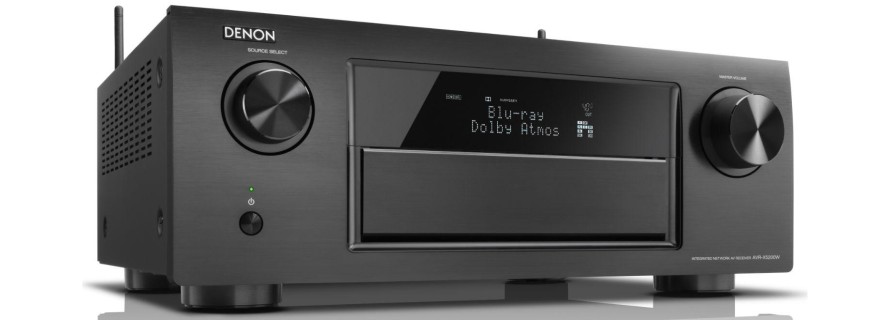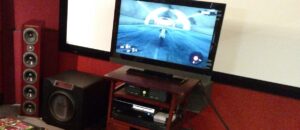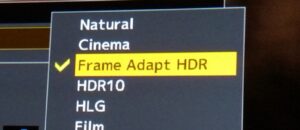Our post last week about the upcoming home version of the Dolby Atmos surround sound format elicited some follow-up questions that weren’t covered in the original conference. I asked Dolby to comment, and the firm has provided some answers.
This post should be read as an addendum to last week’s article on Atmos. Please see that one first for general information about the home version of Dolby Atmos.
In the Comments section to that piece, our readers came back with some good questions. I also thought of a new one myself. I reached out to Joshua Gershman, the Public Relations Manager for Dolby Labs. After conferring with his colleagues and tech experts, he responded with the following:
Q: How much extra disc space will an Atmos track take up on a Blu-ray? Are studios likely to have to choose between either Atmos or 3D in order to maintain a decent video bit-rate, or can a Blu-ray accommodate both Atmos and 3D on the same disc without too much compromise?
A: This depends on the complexity of the content itself. Our initial goals are to minimize overhead to 20% or less. We don’t expect video bitrates to be compromised [due to] the addition of the Dolby Atmos soundtrack on a Blu-ray disc.
Q: One reader has a small dedicated home theater with his main listening position against the back wall. Will this limit him to only to a 5.1.2 setup even though he’d like to use 4 ceiling speakers? How will the sound move across the Atmos channels if the top rear speakers can’t be behind the listening position?
A: A 5.1.2 with 2 overheads in front seems to be the best route. If he is limited to a 5.1.2 setup, it’s recommended to place the two overheads in front of the listening position in the ceiling. Or choose to introduce Dolby Atmos enabled speakers (integrated or module design) to his left and right front speakers.
Something he may want to try is to install the front two overheads as outlined above and experiment with placing Dolby Atmos enabled speakers modules on the side walls in the rear of the room above listening level. The use of Dolby Atmos enabled speaker modules in the rear may create the more diffused soundfield he seeks.
[In a later message, Josh forwarded this additional note.]
Suggest he consider moving the couch slightly forward; installing overhead speakers with wide diffusion characteristics behind the couch is also an option.
Q: Many viewers with traditional 5.1 or 7.1 systems already mount their surround speakers above ear level, either on the ceiling or high on the walls. Does this change the recommendation for a 7.1.4 minimum configuration? I would think that if the surround speakers are already up high, 7.1.2 would be a natural first upgrade. Or is it recommended that they add new surround speakers at seating level?
A: Dolby’s recommendation is that surround speakers do not exceed 1 ½ times the height of the listening position. They could consider adding Dolby Atmos enabled speaker modules above the left back and right back surrounds.
—
If you have additional questions about Atmos, let us know in the Comments and I’ll see if I can get more answers.






Mike H
Thank you so much Josh for forwarding my question about the MLP being in the back of the room to Dolby. This will get the wheels turning for me and allow me to explore different ways to implement Atmos in my home theater. Much appreciated!
Andy Gilleand
Can you answer my question about backwards compatibility with Pro Logic IIz? My current AVR supports PLIIz, which is an older standard, but it’s essentially the same as a 5.1.2 configuration with the two height speakers being placed above the front left and right speakers. Will Atmos tracks be backwards compatible with IIz in a way that will essentially reproduce the height information from the Atmos track in the IIz configuration?
Josh Zyber
AuthorIf you play an Atmos disc without an Atmos receiver, it should behave the same as playing any other 5.1 soundtrack. At least in theory, your ProLogic IIz receiver should extract some height information from that. However, they would be matrixed sounds, not discrete, and not really equivalent to the full Atmos experience.
me
Omg Andy, welcome to 2014…. pl 2 is worse than Sonys fake 5.1… . Spend 150 and join the rest of us in 1985
Josh Zyber
AuthorHe’s talking about ProLogic IIz, which upmixes 5.1 or 7.1 soundtracks to add height channels – not to standard ProLogic or ProLogic II processing of 2.0 audio.
William Henley
Yeah, Prologic II z has been in many receivers for the past 3-5 years. Me, it looks like you should be the one we say “welcome to 2014” to. :-p Most modern 7.1 I have seen will let you choose whether you want to run in a 7.1 or a 5.1.2 setup. I like the height, but I wasn’t willing to give up the 7.1,
DTS has a similar technology that is in a few amps called DTS Neo X, and there are already Blu-Rays encoded in it, although the only one I know of is The Expendables 2
Csm101
Dredd 3d has it also.
Drew
So does ‘Step Up: Revolution’.
Csm101
That dubstep must sound crazy cool in 11.1!
Drew
11.2! Yes! It does! 🙂
Al
“…and experiment with placing Dolby Atmos enabled speakers modules on the side walls in the rear of the room above listening level. The use of Dolby Atmos enabled speaker modules in the rear may create the more diffused soundfield he seeks.”
Josh, were they really telling you that ATMOS is even possible with only 2 overheads, in the back of the listening area? Were they really suggesting a 5.1.2 with the “.2” behind the seats? If this is possible, I may just put ATMOS in my smaller secondary HT, that I use mostly for gaming.
Josh Zyber
AuthorCurrent consensus is that if you’re only going to use 2 overheads, Top Middle seems to be the preferred position that will get you the maximum impact.
Al
But this Dolby representative DID suggest putting the two overheads behind the seats, in a setup that he was aware would only be using two overheads.
Al
Does that give you the impression that DolbyAtmos is just a lot more versatile and flexible than anyone initially imagined?
Al
I’m really surprised to see that Dolby suggested a 5.1.2 setup with the 2 overheads (ATMOS upfiring modules, in this case) in the back. I thought the two ceiling/height/upfiring modules, representing the “.2” in a Dolby ATMOS 5.1.2 setup always has to be in the front. Please give me your takeaway from this.
Josh Zyber
AuthorThis may vary depending on how a specific manufacturer implements Atmos in a specific receiver product, but the Atmos specs do not require that the first two height channels be in the front of the room. I’m pretty sure that my Denon receiver would allow me to do just two speakers in the middle or just two speakers in the rear even if I didn’t have any in the front.
Keep in mind that you will be a little more limited if you plan to use upfiring speaker modules. Those modules have to be placed on top of either your front Left and Right or your Surround Left and Right. If your Surround speakers are at 90-degrees to your seating position, the modules will effectively bounce sound directly over your head in the Top Middle position. Whether the receiver will call that Top Middle or something else, I don’t know, because I don’t have those type of modules.
The modules are angled forward, so even if you have your Surround speakers behind you a little, the modules should still bounce sound toward your seats.
Atmos is quite flexible. I will have a new post about changes I’ve made to my Atmos system coming up next week.
Al
Thanks for the input. Looking forward to your new post.
Josh Zyber
AuthorLet’s just say that I’ve decided there’s no such thing as too many speakers.
Al
I totally agree. I’m running a ridiculous number of speakers, in my dedicated HT.